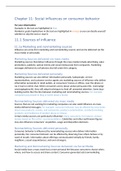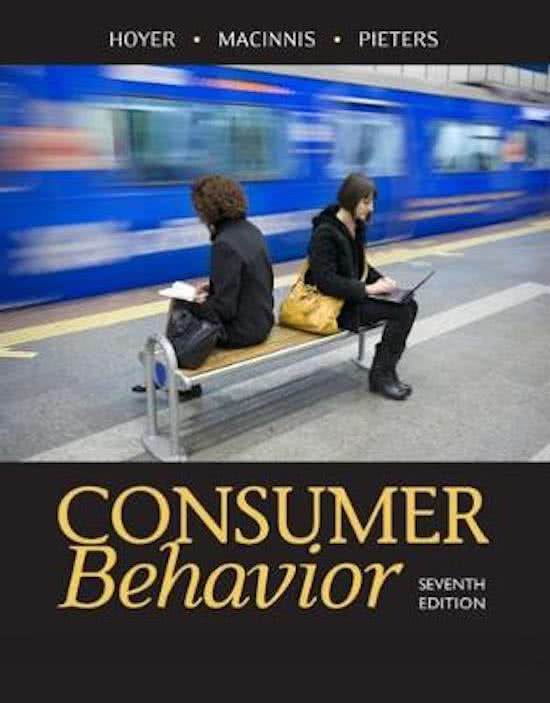Chapter 11: Social influences on consumer behavior
For your information:
Examples in the text are highlighted in blue.
Marketers goals/implications in the text are highlighted in orange so you can decide yourself
whether to skip this text or read it.
11.1 Sources of influence
11.1a Marketing and nonmarketing sources
Influence can come from marketing and nonmarketing sources and can be delivered via the
mass media or personally.
Marketing Sources delivered via mass media
Marketing sources that deliver influence through the mass media include advertising, sales
promotions, publicity, special events and social media posts from companies. Marketing
messages delivered via cell phones also fall under this category.
Marketing Sources delivered personally
Marketing sources can also deliver information personally. Salespeople, service
representatives, and customer service agents are marketing sources of influence who deliver
information personally in retail outlets, at consumers’ homes or offices, over the phone or
via e-mail or online chat. When consumers worry about undue persuasion (NL: overmatige
overtuigingskracht), they will adopt techniques to fend off unwanted attention. Some buzz-
building-tactics blur the line between marketing and nonmarketing sources. For example:
companies pay people to blog or tweet about a brand.
Nonmarketing Sources delivered via mass media
Sources that are not working for marketing companies can also wield influence via mass
media-delivered messages. For example: consumer behavior may be affected by news items
about new products, movies, and restaurants; product contamination; accidents involving
products; and incidences of product abuse or misuse.
Certain media sources are particularly influential. Many consumers, for instance, choose
movies based on film critics’ recommendations. Celebrities and other well-known figures
may also influence consumers’ acquisition, usage and disposition decisions.
Nonmarketing Sources delivered personally
Consumer behavior is influenced by nonmarketing sources who deliver information
personally. Our consumer behavior can be affected by observing how others behave or by
word of mouth, information about offerings communicated verbally by friends, family,
neighbors, casual acquaintances, and even strangers.
Marketing and Nonmarketing Sources delivered via Social Media.
Social media have a mass reach but a more personal feel because consumers choose when,
where, and how to access and share content. Consumer-generated ads (nonmarketing
,sources encouraged or even rewarded by many marketers) can stimulate a range of social
media conversations, from positive and negative comments, to debate over content and
interest in knowing more about the ad and the brand. Reaction to marketing sources
delivered via social media is likely to be positive when the content is entertaining,
informative, or is valued in some other way by the consumer audience.
11.1b How do these general sources differ?
Reach
Mass media sources are important to marketers because they reach large consumer
audiences.
Capacity for two-way communication
Personally delivered sources of influence are valuable because they allow for a two-way flow
of information. For example: a car salesperson may have more influence than a car ad
because the salesperson can tailor sales information to fit the buyer’s information needs,
rebut counterarguments, reiterate important and/or complex information and answer the
buyer’s questions.
Personal conversations are often more casual (NL: relax, toevallig) and less purposeful than
mass media-delivered information. During a conversation, people are less likely to anticipate
what will be said and hence are less likely to take steps to avoid information inconsistent with
their own frames of reference.
Information from a personal source may also seem more vivid than information from the
mass media because the person speaking somehow makes it more real, a factor that may
make it more persuasive.
Credibility
Consumers tend to perceive information delivered through marketing sources as being less
credible, more biased and manipulative. Nonmarketing sources appear more credible
because we do not believe that they have a personal stake in our purchase, consumption or
disposition decisions.
Because nonmarketing sources are credible, they tend to have more influence on consumer
decisions than marketing sources do.
We tend to believe information that we hear from people with whom we have close
relationships, in part because their similarity to us (and our values and preferences) makes
their opinions credible. Certain people are also regarded as more credible than others
because they are experts or are generally recognized as having unbiased opinions.
For example: research shows that publicity delivered via blogs can generate higher brand
attitudes and purchase intensions than publicity delivered via online magazines, simply
because of the bloggers credibility.
11.1c Opinion leaders
A special source of social influence is the opinion leader, someone who acts as an
information broker between the mass media and the opinions and behaviors of an individual
or group. Opinion leaders have some position, expertise, or firsthand knowledge that makes
them particularly important sources of relevant and credible information, usually in a specific
domain or product category.
,Opinion leaders are regarded as nonmarketing sources of influence, a perception that ads to
their credibility, they are not necessarily well-known people and they have enduring
involvement with a product category.
Opinion leaders are part of a general category of gatekeepers: people who have special
influence or power in deciding whether a product or information will be disseminated to a
market.
Opinion leaders have influence because they generally have no personal stake in whether
their opinions are heeded, so their opinions are perceived as unbiased and credible. They are
also regarded as knowledgeable about acquisition, usage and disposition options because of
their product knowledge and expertise. It does not mean that information only flows from
opinion leaders to consumers, opinion leaders often get information by seeking it from
consumers, manufacturers and retailers.
Researchers have also identified another special source of influence- a market maven:
someone who seems to have a lot of information about the marketplace in general.
11.2 Reference groups as sources of influence
A reference group is a set of people with whom individuals compare themselves for guidance
in developing their own attitudes, knowledge and/or behaviors.
11.2a types of reference groups
Consumers may relate to three types of reference groups: aspirational, associative, and
dissociative
- Aspirational reference groups: are groups we admire and wish to be like but are not
currently a member of. Knowing their target consumers’ aspirational reference group
enables marketers to associate their product with that group and to use
spokespeople who represent it.
- Associative reference groups: are groups to which we actually belong, such as a
clique of friends, an extended family. The gender, ethnic, geographic and age groups
to which you belong are also associative reference groups with whom you may
identify. When consumers misunderstand their relative position in a reference group,
they tend to make poor acquisition or consumption decisions. For example: if you
believe you are one of the most skillful cyclists or skiers in your class – when in reality,
you are just beyond beginner status – you may buy equipment or services unsuited to
your capabilities. Associative reference groups can form around a brand. A brand
community is a specialized group of consumers with a structured set of relationships
involving a particular brand, fellow customers of that brand, and the product in use.
Members of a brand community not only buy the product repeatedly, but they are
extremely committed to it, share information and enthusiasms and influence other
members to remain loyal.
- Dissociative reference groups: are groups whose attitudes, values and behavior we
disapprove of and do not wish to emulate. (NL: nastreven). Note that the influence of
dissociative reference groups can depend, in part, on whether a product is consumed
in public or in private.
, 11.b characteristics of reference groups
Reference groups can be described according to the degree of contact, formality, similarity
among members, group attractiveness, density degree of identification and strength of the
ties connecting members.
- Degree of contact: reference groups vary in their degree of contact. We may have
direct and extensive contact with some reference groups like our immediate circle of
friends but may have less contact with others like politicians. Reference with which
we have considerable contact tend to exert the greatest influence. A group with
which we have face-to-face interaction, such as family, is a primary reference group.
In contrast, a secondary reference group is one that may influence us even though
we have no personal contact with most of its members.
- Formality: reference groups also vary in formality. Groups like athletic teams, clubs
and classes are formally structured, with rules outlining the criteria for group
membership and the expected behavior of members. For example: you. Must satisfy
certain requirements before you can enroll in particular college courses. Other groups
are more ad hoc, less organized and less structured. For example: your immediate
group of friends is not formally structured and portably has no official rules.
- Homophily: the similarity among group members. When groups are homophilous,
reference-group influence is likely to be strong because similar people tend to see
things in the same way, interact frequently and develop strong social ties. Because
senders and receivers are similar, the information that they share is also likely to be
perceived as credible. Marketers may us the concept of homophily to market their
products. For example, if you log on to amazon.com and fin a book you like, the
recommendation system points you to more books you might like based on the
purchases of consumers who bought the first book.
- Group attractiveness: when members perceive a group as being very attractive, they
have stronger intentions to conform to what the group does, even if its illicit (NL:
ongeoorloofde) consumption behavior.
- Density: dense groups are those in which group members all know one another. In
contrast, the network of faculty at a large university is less dense because its
members have fewer opportunities to interact, share information or influence on
another. In many countries, network density varies by geographic area.
- Degree of identification: some characteristics of an individual within a group
contribute to the ways in which groups vary. One is the degree of identification that a
consumer has with a group. Just because people are members of a group does not
mean that they use it as a reference group. The influence that a group has on an
individual’s behavior is affected by the extent to which he or she identifies with it.
One study found that consumers who attend sporting events were more likely to buy
a sponsor’s products when they strongly identified with the team and viewed such
purchases as a group norm. Moreover, a marketing stimulus that focuses attention on
consumers’ identification with a certain group and is relevant to that identification
will more likely elicit a positive response.
- Tie-strength: A strong tie means that two people are connected by a close, intimate
relationship often characterized by frequent interpersonal contact. Weak ties often
serve as ‘bridges’ connecting groups, they can play a powerful role in propagating
information across networks. Researchers have found that word of mouth spreads
more broadly among people with weak ties.






